
Higher_Mathematics_Part_3
.pdf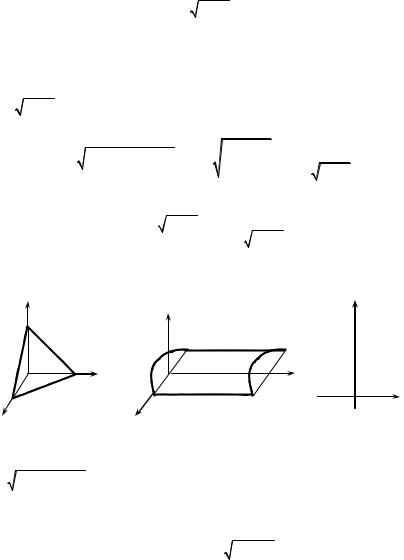
Example 2. Evaluate the surface integral of the first type I = ∫∫ z(x + 2y)dσ,
σ
where σ is the part of the surface z = 1− x2 bounded by the planes y = 0 and y = 3 (Fig. 8.9).
|
Solution. The projection of the given surface to the plane Оху is the |
||||||||||
rectangular: |
−1 ≤ x ≤ 1, |
0 ≤ y ≤ 3 (Fig. |
8.10). We’ll find |
partial derivatives |
|||||||
z′ |
= |
− x |
, z′ |
= 0, |
|
|
|
|
|
|
|
|
|
|
|
|
|
|
|
||||
x |
|
1− x2 |
y |
|
|
|
|
|
|
|
|
|
|
|
|
|
|
|
|
|
|
|
|
|
Then |
|
|
|
|
|
|
|
|
|
|
|
|
d |
σ = |
1+ (z′ )2 + (z′ )2 dxdy = |
1+ |
x2 |
dxdy = |
|
dxdy |
. |
|
|
|
|
|
|
|||||||
|
|
|
|
x |
y |
1− x2 |
|
|
1− x2 |
||
|
|
|
|
|
|
|
|
||||
|
Now we’ll evaluate the surface integral |
|
|
|
|
||||||
I = ∫∫ z(x + 2y)dσ = I = ∫∫ |
1− x2 (x + 2y) |
dxdy |
|
= ∫∫ (x + 2y)dxdy = |
||||||||||||||||
1− x2 |
|
|||||||||||||||||||
|
|
σ |
|
|
D |
|
|
|
|
|
|
D |
|
|
|
|
|
|
|
|
1 |
|
3 |
|
1 |
|
2 |
|
3 |
1 |
|
|
3 |
|
2 |
|
|
|
1 |
|
|
|
|
|
|
|
|
|
|
|||||||||||||
= ∫ dx∫ (x + 2y)dy = ∫ (xy + y |
|
) |
|
dx = ∫ (3x + 9)dx |
= |
|
x |
|
+ 9x |
|
= 18. |
|||||||||
|
|
|
|
|||||||||||||||||
−1 |
0 |
|
−1 |
|
|
|
0 |
−1 |
|
2 |
|
|
|
|
|
−1 |
||||
z |
|
|
|
z |
|
|
|
|
|
|
|
|
|
|
у |
|
|
|
||
1 |
|
|
|
|
|
|
|
|
|
|
|
|
|
3 |
|
|
|
|||
|
|
|
|
|
|
|
|
|
|
|
|
|
|
|
|
|
|
|||
|
|
|
|
|
|
1 |
|
|
|
|
|
|
|
|
|
|
|
|
|
|
|
O |
1 |
у |
|
|
|
O |
|
3 |
|
у |
|
|
|
|
|
|
|
||
|
|
|
|
|
1 |
|
|
|
|
|
|
|
|
|
|
|
|
|
|
|
х |
|
|
х |
|
|
|
|
|
|
|
|
|
|
–1 O |
|
1 х |
||||
|
|
|
|
|
|
|
|
|
|
|
|
|
|
|
|
|
|
|||
Fig. 8.8 |
|
|
|
|
|
|
Fig. 8.9 |
|
|
|
|
|
|
Fig. 8.10 |
||||||
Example 3. Find |
coordinates |
of the centre of mass |
for the |
hemisphere |
||||||||||||||||
z = R2 − x2 − y2 |
(Fig. 8.11) if its surface density at each point is numerically |
|||||||||||||||||||
equal to the distance of this point to the radius, perpendicular to the basis of the hemisphere.
Solution. Under the condition of the problem the surface density at a point
(x, y, z) is defined by the formula γ = x2 + y2 . From symmetry of the hemisphere to the axis Оz and the function γ(x, y) comparatively to the point (0; 0) it follows, that the centre of mass is placed on the axis Оz. So, xc = yc = 0 and we’ll define coordinate zc accordingly the formula (8.7).
191
http://vk.com/studentu_tk, http://studentu.tk/
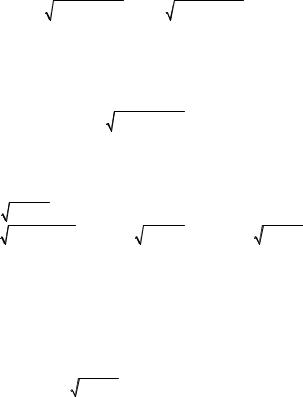
Let’s transform an element dσ. As
|
|
z′ |
= |
|
− x |
, z′ |
= |
|
− y |
|
|
, |
|||
|
|
|
|
|
|
|
|
|
|||||||
|
|
x |
|
R2 − x2 − y2 |
|
y |
|
|
R2 − x2 − y2 |
|
|
||||
then |
|
|
|
|
|
|
|
|
|
||||||
|
|
|
|
|
|
|
|
|
|
|
|
|
|
|
|
1 |
+ (z′ )2 |
+ (z′ )2 |
= 1+ |
x2 |
|
+ |
|
|
y2 |
= |
|
R2 |
|||
|
|
|
|
|
|
|
|
|
|||||||
|
x |
y |
|
|
R2 − x2 − y2 |
|
R2 − x2 − y2 |
|
R2 − x2 − y2 |
||||||
and |
|
|
|
|
|
|
|||||||||
|
|
|
|
|
|
Rdxdy |
|
|
|
|
|
||||
|
|
|
|
|
dσ = |
|
|
. |
|
|
|
||||
|
|
|
|
|
|
|
|
|
|
|
|
|
|
||
R2 − x2 − y2
Considering that the projection of the surface to the plane Оху is the disk of
radius R, bounded with the circle x2 + y2 |
= R2 , |
we make calculations in polar |
|||||||||||||||||||||||||||||||||||||
coordinates system. We have |
|
|
|
|
|
|
|
|
|
|
|
|
|
|
|
|
|
|
|
|
|
|
|
|
|
|
|
||||||||||||
|
|
|
x2 + y2 dxdy |
2π |
R |
|
|
ρ |
|
|
|
|
|
|
|
|
|
|
R |
ρ2dρ |
|
|
|
||||||||||||||||
m = R ∫∫ |
|
|
|
|
|
|
|
|
|
|
= R ∫ dϕ∫ |
|
|
|
|
|
|
|
|
ρdρ = 2πR∫ |
|
|
|
|
|
|
|
= |
|||||||||||
|
R |
2 |
− x |
2 |
− y |
2 |
|
|
R |
2 |
− ρ |
2 |
|
R |
2 |
− ρ |
2 |
||||||||||||||||||||||
|
Dxy |
|
|
|
0 |
0 |
|
|
|
|
|
|
|
|
|
|
|
0 |
|
|
|
|
|||||||||||||||||
|
ρ = R sin t, |
|
|
|
|
π |
|
|
|
|
|
|
|
|
|
|
|
|
|
|
|
|
π |
|
|
|
|
|
|
|
|||||||||
|
|
|
|
|
|
|
|
|
|
|
|
|
|
|
|
|
|
|
|
|
|
|
|
|
|
|
|
||||||||||||
|
|
|
= 2πR∫2 |
R2 sin2 t R costdt |
= 2πR3 ∫2 sin2 tdt = |
||||||||||||||||||||||||||||||||||
= |
dρ = R costdt, |
||||||||||||||||||||||||||||||||||||||
|
|
|
|
||||||||||||||||||||||||||||||||||||
|
0 ≤ t ≤ π / 2 |
|
|
|
|
0 |
|
|
R cost |
|
|
|
|
|
|
|
|
0 |
|
|
|
|
|
|
|
|
|||||||||||||
|
|
|
|
|
|
|
|
|
|
|
|
|
|
|
|
|
|
|
|
|
|
|
|
|
|
|
|
|
|
|
|
||||||||
|
|
|
|
|
|
|
π |
|
|
|
|
|
|
|
|
|
|
|
|
|
sin 2t |
|
π |
|
π2 R3 |
|
|
|
|
|
|
|
|||||||
|
|
|
|
|
|
|
|
|
|
|
|
|
|
|
|
|
|
|
|
|
|
|
|
|
|
|
|
||||||||||||
|
|
|
|
|
|
|
2 |
|
|
|
|
|
|
|
|
|
|
|
|
|
|
|
|
|
|
|
|
|
|||||||||||
|
|
|
|
|
|
3 |
|
|
|
|
|
|
|
|
3 |
|
|
|
|
2 |
|
|
|
|
|
|
|
|
|||||||||||
|
|
= πR |
|
∫(1− cos 2t)dt = πR |
|
t − |
|
|
|
|
|
|
|
= |
|
|
|
; |
|
|
|
|
|
|
|||||||||||||||
|
|
|
|
|
|
2 |
|
|
|
|
2 |
|
|
|
|
|
|
||||||||||||||||||||||
|
|
|
|
|
|
|
0 |
|
|
|
|
|
|
|
|
|
|
|
|
|
|
|
|
|
0 |
|
|
|
|
|
|
|
|
|
|
||||
|
|
|
|
|
|
|
|
|
|
|
|
|
|
|
|
|
|
|
2π |
|
R |
|
|
|
|
2πR |
4 |
|
|
|
|
|
|
||||||
|
∫∫ zγ dσ =R ∫∫ |
|
x2 + y2 dxdy =R ∫ dϕ∫ρ2dρ = |
|
. |
|
|
|
|
||||||||||||||||||||||||||||||
|
|
3 |
|
|
|
|
|
||||||||||||||||||||||||||||||||
|
σ |
|
|
|
|
|
|
Dxy |
|
|
|
|
|
|
|
|
|
0 |
|
0 |
|
|
|
|
|
|
|
|
|
|
|
|
|
||||||
|
|
|
|
|
|
|
|
|
|
|
|
|
|
|
|
|
|
|
|
|
|
|
|
|
|
|
|
|
|
|
|
||||||||
So, |
|
|
|
|
|
|
|
|
|
|
|
|
|
|
|
|
|
|
|
|
|
|
|
|
|
|
|
|
|
|
|
|
|
|
|
|
|||
|
|
|
|
|
|
|
|
|
|
|
|
|
|
2πR4 |
|
|
|
4R |
|
|
|
|
|
|
|
|
|
|
|
|
|
|
|
|
|||||
|
|
|
|
|
|
|
|
|
|
|
|
zc = |
3 |
|
= |
|
. |
|
|
|
|
|
|
|
|
|
|
|
|
|
|
|
|||||||
|
|
|
|
|
|
|
|
|
|
|
|
π2 R3 |
|
3π |
|
|
|
|
|
|
|
|
|
|
|
|
|
|
|
||||||||||
|
|
|
|
|
|
|
|
|
|
|
|
|
|
|
|
|
|
|
|
|
|
|
|
|
|
|
|
|
|
|
|
|
|||||||
|
|
|
|
|
|
|
|
|
|
|
|
|
|
2 |
|
|
|
|
|
|
|
|
|
|
|
|
|
|
|
|
|
|
|
|
|
|
|||
Example 4. Evaluate the surface integral of the second type |
I = ∫∫ xdydz + |
||||||||||||||||||||||||||||||||||||||
+ zdxdz + 3dxdy, |
where |
|
σ |
|
is the |
upper |
|
side |
of |
|
|
the |
|
part |
of |
σ |
|||||||||||||||||||||||
|
|
|
|
|
|
the plane |
|||||||||||||||||||||||||||||||||
2x − 3y + 3z − 6 = 0 ( x ≥ 0, y ≤ 0, z ≥ 0 ).
Solution. The given surface σ, being the part of plane, is represented on the Fig. 8.12. The normal n corresponding to the upper side of the surface forms the
192
http://vk.com/studentu_tk, http://studentu.tk/
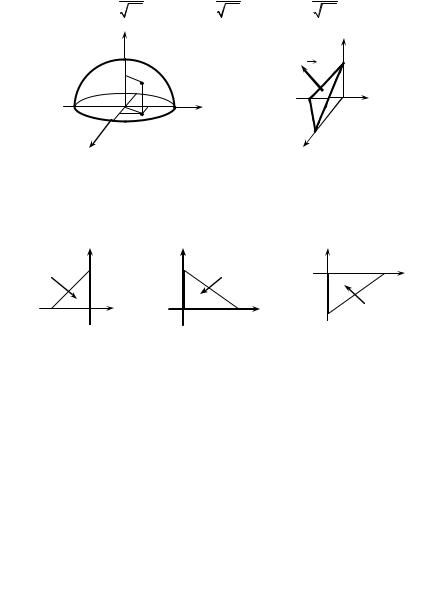
acute angles with axes Oh and Oz and the obtuse angle with the axis Оу. Actually, the normal n = {2; − 3; 3} has such directing cosines:
cos α = 2 |
> 0, |
cosβ = |
−3 |
< 0, cos γ = |
3 > 0 . |
22 |
|
|
22 |
|
22 |
z |
|
|
|
|
z |
R |
|
|
|
|
|
|
|
|
|
2 |
|
|
|
|
|
|
|
d |
|
|
|
|
n |
|
|
|
|
|
|
О |
y |
R у |
|
–2 |
О у |
х |
|
|
|
||
R |
|
|
|
3 |
|
х |
|
|
|
|
х |
Fig. 8.11 |
|
|
|
|
Fig. 8.12 |
Therefore the surface integral is reduced to the sum of three double integrals over the domains represented on Fig. 8.13, the first and third taken with the sign «+» and the second taken with the sign «–».
|
z |
z |
|
у |
|
Dyz |
2 |
2 |
Dxz |
О |
3 х |
|
|
|
|
||
–2 |
О у |
О |
3 х |
–2 |
Dxy |
|
Fig. 8.13
So, we have
I = ∫∫ xdydz + zdxdz + 3dxdy = ∫∫ xdydz − ∫∫ zdxdz + ∫∫ 3dxdy =
σ |
|
|
|
|
|
|
|
|
Dyz |
|
|
Dxz |
|
Dxy |
|
|
|
y+ 2 |
|
|
|
|
|
3 |
6− 2x |
|
|
||
|
|
0 |
6 + |
3y − 3z |
|
3 |
|
1 |
|
|||||
|
= ∫ dy ∫ |
dz −∫ dx |
∫ zdz +3 |
3 2 = |
||||||||||
|
|
|
|
2 |
2 |
|||||||||
|
|
−2 |
0 |
|
|
|
|
0 |
0 |
|
|
|||
0 |
|
|
|
3 |
|
2 |
|
3 |
(6 − 2x)2 |
|
|
|||
= ∫ |
|
3y + 3 + |
|
y |
|
dy − |
∫ |
|
|
dx + 9 = −4 − 2 + 9 = 3. |
||||
4 |
|
18 |
|
|||||||||||
−2 |
|
|
|
|
|
|
0 |
|
|
|
|
|
||
Example 5. Evaluate the surface integral of the second type ∫∫ zdxdy, if σ is
σ
the external side of sphere x2 + y2 + z2 = R2 (Fig. 8.14).
193
http://vk.com/studentu_tk, http://studentu.tk/
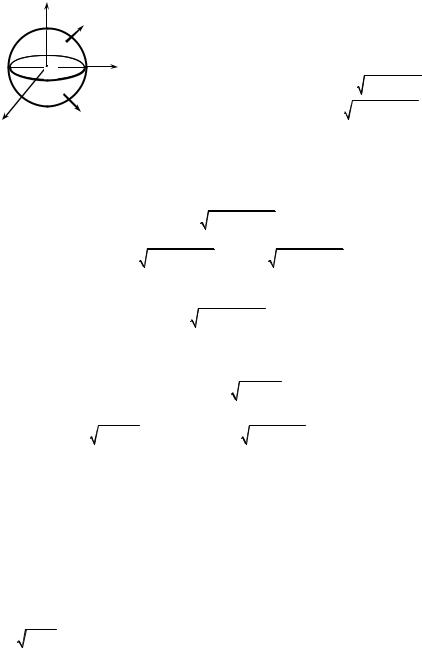
z G
R n
 О R у
О R у
G
R n
х
Fig. 8.14
Solution. The upper and the lower hemispheres are projected on the plane Оху in same domain, i.e.
the circle limited by a circle x2 + y2 = R2 . That is why we divide the surface σ into the part σ1 and the part
σ2 , where σ1 is the upper hemisphere z = R2 − x2 − y2 ,
and σ2 |
is the lower hemisphere z = − R2 − x2 − y2 . |
||
So, |
∫∫ zdxdy = ∫∫ zdxdy + ∫∫ zdxdy . |
||
|
σ |
σ1 |
σ2 |
We’ll reduce each of integrals to the double one, considering, that a normal vector on the selected side of the upper hemisphere forms with the axis Oz an acute angle, and an obtuse angle with bottom hemisphere. So,
|
∫∫ zdxdy = + ∫∫ |
R2 − x2 − y2 dxdy , |
|
|
σ1 |
Dxy |
|
∫∫ zdxdy = − ∫∫ − |
R2 − x2 − y2 dxdy = ∫∫ R2 − x2 − y2 dxdy . |
||
σ2 |
Dxy |
|
Dxy |
Then |
|
|
|
|
∫∫ zdxdy = 2 ∫∫ |
R2 − x2 − y2 dxdy = I. |
|
|
σ |
Dxy |
|
Now we’ll pass to polar coordinates and we’ll get
|
|
|
|
|
2π |
R |
|
|
|
|
|
|
I = ∫∫ zdxdy = 2 ∫ dϕ∫ |
R2 − ρ2 ρdρ = |
|
|
|
||||||||
σ |
|
|
|
|
0 |
0 |
|
|
|
|
|
|
R |
d (R |
2 |
− ρ |
2 |
) |
|
4 |
|
R |
|
4 |
|
|
|
|
|
|||||||||
= 4π∫ R2 − ρ2 |
|
|
= − |
π (R2 − ρ2 )3 |
|
= |
πR3. |
|||||
|
−2 |
|
|
3 |
3 |
|||||||
0 |
|
|
|
|
|
0 |
|
|
||||
Example 6. Evaluate the surface integral of the second type. ∫∫ 2xdydz − ydxdz,
σ
where σ is the external side of the part of the surface of the cylinder x2 + y2 = 1,
0 ≤ z ≤ 1, x ≥ 0, y ≥ 0 (Fig. 8.15). |
|
|
Solution. We’ll consider the given integral |
as the sum of two |
integrals |
I = I1 + I2 . For evaluation of the surface integral |
I1 = ∫∫ 2xdydz we project the |
|
|
σ |
0 ≤ z ≤ 1 |
surface σ on the plane Oyz. We’ll get the rectangular σ yz : 0 ≤ y ≤ 1, |
||
(Fig. 8.16). Now we’ll solve the equation of the cylinder comparatively to the x: x = 1− y2 (the condition x ≥ 0 ). As the normal vector n at any point of the
194
http://vk.com/studentu_tk, http://studentu.tk/
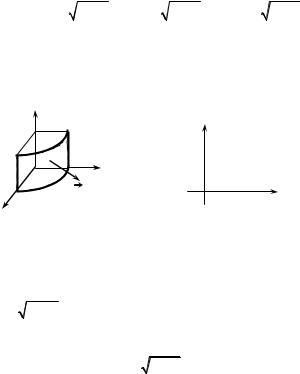
selected side of the surface σ forms with the axis Ox an acute angle, then we take the corresponding double integral with the sign «+». We have
I1 = ∫∫ 2xdydz = ∫∫ 2 |
1 |
1 |
1 |
|
1− y2 dydz = 2∫ |
1− y2 dy∫ dz = 2∫ 1− y2 dy = |
|||
σ |
σ yz |
0 |
0 |
0 |
|
y = sin t, |
|
|
|
|
|
π |
|
|
|
1 |
π |
1 |
|
|
sin 2t |
|
|
π |
|
π |
|
||||||
|
|
|
|
|
|
|
|
|
|
|
|
|||||||||||||||||
|
|
|
|
|
|
|
|
|
|
|
|
|
||||||||||||||||
|
|
|
|
|
2 |
|
|
|
2 |
|
|
|
|
|
|
|||||||||||||
|
|
|
|
|
|
|
|
2 |
|
|
|
|
|
2 |
|
|
||||||||||||
= |
dy = cos tdt, |
|
= ∫cos |
|
tdt = |
|
∫(1+ cos 2t)dt = |
|
|
t |
+ |
|
|
|
|
|
|
= |
|
. |
||||||||
|
|
|
|
|
|
|
|
|
|
|
||||||||||||||||||
|
0 ≤ t ≤ π |
/ 2 |
|
|
|
0 |
|
|
|
2 |
0 |
|
2 |
|
|
|
2 |
|
|
0 |
|
2 |
|
|||||
|
|
|
z |
|
|
|
|
|
|
|
|
z |
|
|
|
|
|
|
|
|
|
|
|
|
|
|
||
|
|
|
|
|
|
|
|
|
|
|
|
|
|
|
|
|
|
|
|
|
|
|
|
|
||||
|
|
|
1 |
|
|
|
|
|
|
|
|
|
|
|
|
|
|
|
|
|
|
|
|
|
|
|||
|
|
|
|
|
|
|
|
|
1 |
|
|
|
1 |
|
|
|
|
|
|
|
|
|
|
|
|
|
|
|
|
|
|
|
|
|
|
|
|
|
|
|
|
|
|
|
|
|
|
|
|
|
|
|
|
|
|
||
|
|
|
|
|
|
|
|
|
|
|
|
|
|
|
|
|
|
|
|
|
|
|
|
|
|
|
|
|
|
|
|
|
|
|
|
|
|
у |
|
|
|
|
σyz |
|
|
|
|
|
|
|
|
|
|
|
|||
|
|
|
|
|
O |
n |
|
|
|
|
|
|
|
|
|
|
|
|
|
|
|
|||||||
|
|
|
|
|
|
|
|
|
|
|
|
|
|
|
|
|
|
|
|
|
|
|
|
|
|
|
||
|
|
|
|
|
|
|
|
|
|
|
|
|
|
|
|
|
|
|
|
|
|
|
|
|
|
|
||
|
х |
1 |
|
|
|
|
|
|
|
O |
|
|
|
|
|
|
1 у |
|
|
|
|
|
|
|||||
|
|
|
|
|
|
|
|
|
|
|
|
|
|
|
|
|
|
|
|
|
|
|||||||
|
|
|
|
|
|
|
|
|
|
|
|
|
|
|
|
|
|
|
|
|
|
|
|
|
|
|
|
|
|
|
|
Fig. 8.15 |
|
|
|
|
|
Fig. 8.16 |
|
|
|
|
|
|
|
|
|||||||||||
Similarly we evaluate the integral I2 = −∫∫ ydxdz. For this purpose we
σ
project the surface on the plane Оxz and solve the equation of a surface with
respect to y: y = 1− x2 . Then we pass to the double integral (a sign of double integral is the same, as the sign of the surface integral). Then
|
|
1 |
1 |
π , |
I2 = −∫∫ ydxdz = −∫ 1− x2 dx∫ dz = − |
||||
σ |
|
0 |
0 |
4 |
|
|
|||
And finally we receive I = π − |
π = |
π . |
|
|
2 |
4 |
4 |
|
|
Example 7. Evaluate the surface integral of the second type |
||||
I = ∫∫ x2dxdz + xdxdz + xzdxdy, |
|
|||
σ |
|
|
|
|
where σ is the upper side of that surface part |
y = x2 + z2 |
which is placed in the |
||
first octant between planes y = 0 and |
y = 1. |
|
|
|
Solution. We’ll represent the surface σ. The equation y = x2 + z2 determines a paraboloid of the rotation around the axis Oy. And its part which is placed in the first octant, crosses coordinate plane Oyz on the parabola y = z2 , and plane Oxy
195
http://vk.com/studentu_tk, http://studentu.tk/
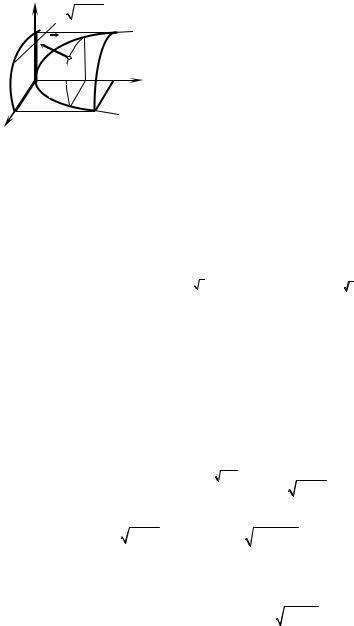
1 x
z |
|
|
|
|
|
|
|
2 |
|
|
z = 1−x2 |
on the parabola |
y = x . With the plane |
y = 1 the |
|||||||
|
||||||||||
1 |
|
|
|
y = z2 |
paraboloid is crossed along the circle x2 + z2 = 1 , |
|||||
|
|
σ |
||||||||
|
|
n |
|
|
|
the quarter of this circle lays in the first octant. |
||||
σxz |
σyz |
|
|
|
|
Eventually, if |
y = 0, then x2 + z2 = 0. |
Only one |
||
|
|
|
y |
point (the Origine) satisfies this equation. As a result |
||||||
|
|
σxy |
|
|
1 |
of the analysis carried we constract the surface σ |
||||
|
|
|
|
|
|
|
(Fig. 8.17). |
|
n at any |
|
|
|
|
|
y = x2 |
Let’s notice, that the normal vector |
|||||
|
|
|
|
|
|
|
point of the selected side of a surface |
σ creates |
||
|
|
Fig. 8.17 |
acute angle with axes Ox and Oz, and it creates |
|||||||
|
|
|
|
|
|
|
obtuse angle with the axis Oy. |
|
||
Let’s evaluate three integrals in series. |
|
|
||||||||
1) |
I1 = ∫∫ x2 dydz . |
|
|
|
||||||
|
|
|
σ |
|
|
|
||||
From the surface equation y = x2 + z2 it followes that x2 = y − z2 and we pass to double integral behind a projection σ yz . As the normal vector n creates acute angle with the axis Ox (see Fig. 6.16) before double integral we put a plus sign:
|
2 |
|
|
1 |
|
y |
|
|
|
|
2 |
|
|
|
|
|
1 |
|
z3 |
|
y |
||
|
|
|
|
|
|
|
|
|
|
|
|
|
|
|
|||||||||
I1 = ∫∫ ( y − z |
|
)dydz |
= ∫ dy ∫ ( y − z |
|
)dz |
= ∫ yz − |
|
|
|
dy = |
|||||||||||||
|
|
3 |
|||||||||||||||||||||
σ yz |
|
|
|
0 |
0 |
|
|
|
|
|
|
|
|
|
|
0 |
|
|
|
0 |
|||
|
|
|
1 |
3 |
|
|
|
|
|
|
5 |
|
1 |
|
|
|
|
||||||
|
|
|
2 |
|
2 |
|
2 |
|
|
|
|
|
4 |
|
|
|
|
|
|||||
|
|
= |
∫ y |
|
dy = |
|
y |
|
|
|
= |
|
. |
|
|
|
|
||||||
|
|
2 |
2 |
|
|
|
|
|
|
|
|||||||||||||
|
|
3 |
3 |
5 |
|
|
15 |
|
|
|
|
||||||||||||
|
|
|
0 |
|
|
|
|
|
|
|
|
0 |
|
|
|
|
|
|
|||||
2) I2 = ∫∫ xdxdz.
σ
The integrand does not contain variable y, therefore we pass directly to the double integral behind a projection σxz . From Fig. 8.17 it is сlear, that a normal
n corresponding to the upper side of a surface σ , creates an obtuse angle with the axis Oy, therefore double integral we take with a minus sign:
|
|
|
|
1 |
1− x2 |
1 |
|
|
|
|
|
|||
I2 |
= − ∫∫ xdxdz = −∫ xdx |
∫ |
|
dz = −∫ x 1− x2 dx = |
||||||||||
|
|
|
σ xz |
0 |
0 |
|
|
0 |
|
|
|
|
|
|
|
|
1 |
1 |
|
1 |
|
|
2 |
|
|
1 |
|
1 |
|
|
|
|
|
|
|
|
||||||||
= |
∫ 1− x2 d (1− x2 ) = |
|
|
(1− x2 )3 |
|
|
= − |
. |
||||||
2 |
2 |
|
3 |
3 |
||||||||||
|
0 |
|
|
|
|
|
0 |
|
|
|||||
3)I3 = ∫∫ xzdxdy .
σxy
From the surface equation we find that z = ± y − x2 , but we take a plus sign before the root because z ≥ 0 in the first octant, and we pass to the double
196
http://vk.com/studentu_tk, http://studentu.tk/
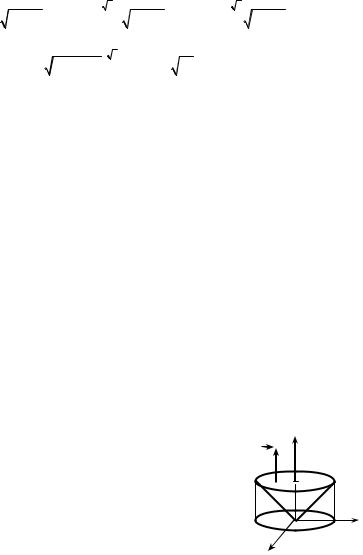
integral behind a projection σxy , having taken integral with a plus sign (the normal n creates an acute angle with the axis Oz):
|
|
|
|
|
|
|
|
|
|
|
|
1 |
|
|
|
y |
|
|
|
|
|
1 |
1 |
|
|
|
y |
|
|
|
|
|
|
|
|
||||
I3 = ∫∫ x |
y − x2 dxdy = ∫ dy ∫ x |
y − x2 dx = − |
∫ dy ∫ |
y − x2 d( y − x2 ) = |
|||||||||||||||||||||||||||||||||||
|
|||||||||||||||||||||||||||||||||||||||
σ |
xy |
|
|
|
|
|
|
|
|
|
|
0 |
|
|
0 |
|
|
|
|
|
|
2 |
0 |
|
|
0 |
|
|
|
|
|
|
|
|
|
||||
|
|
|
|
|
|
|
|
|
|
|
|
|
|
|
|
|
|
|
|
|
|
|
|
|
|
|
|
|
|
|
|
|
|
|
|
|
|
||
|
|
|
1 |
|
1 |
2 |
|
|
|
|
|
|
|
|
|
y |
|
|
|
1 |
1 |
|
|
1 |
|
|
2 |
|
5 |
|
1 |
|
|
|
2 |
|
|||
|
|
|
|
|
|
|
|
|
|
|
|
|
|
|
|
|
|
|
|
|
|
|
|
|
|
||||||||||||||
|
= − |
∫ |
|
|
( y − x2 )3 |
|
|
|
|
dy = |
∫ y3 dy = |
|
|
y |
|
|
|
= |
|
|
. |
||||||||||||||||||
|
|
|
|
|
|
|
|
2 |
|
|
|
|
|||||||||||||||||||||||||||
|
|
3 |
|
|
|
|
|
|
|
|
|
|
15 |
||||||||||||||||||||||||||
|
|
2 |
|
0 |
|
|
|
|
|
|
|
|
0 |
|
|
3 |
0 |
|
3 |
5 |
|
|
|
0 |
|
|
|||||||||||||
|
|
|
|
|
|
|
|
|
|
|
|
|
|
|
|
|
|
|
|
|
|
|
|
|
|
|
|
|
|
|
|
|
|||||||
So, I = I |
+ I |
|
|
+ I |
|
= |
4 |
− |
1 |
|
+ |
2 |
|
= |
1 |
. |
|
|
|
|
|
|
|
|
|
|
|
|
|
|
|
|
|||||||
2 |
3 |
|
|
|
|
|
|
|
|
|
|
|
|
|
|
|
|
|
|
|
|
||||||||||||||||||
|
1 |
|
|
|
|
|
15 |
3 |
15 |
|
15 |
|
|
|
|
|
|
|
|
|
|
|
|
|
|
|
|
|
|
||||||||||
|
|
|
|
|
|
|
|
|
|
|
|
|
|
|
|
|
|
|
|
|
|
|
|
|
|
|
|
|
|||||||||||
|
|
|
|
|
|
|
|
|
|
|
|
|
|||||||||||||||||||||||||||
Example 8. Evaluate the surface integral of the second type |
|
|
|
|
|
||||||||||||||||||||||||||||||||||
|
|
|
|
|
|
|
|
|
|
|
I = ∫∫ xdydz + zdxdz + 3dxdy, |
|
|
|
|
|
|
|
|
|
|
|
|||||||||||||||||
|
|
|
|
|
|
|
|
|
|
|
|
|
σ |
|
|
|
|
|
|
|
|
|
|
|
|
|
|
|
|
|
|
|
|
|
|
|
|
||
where σ is the external side of the pyramid bounded by the |
x = 0, |
y = 0, z = 0 |
|||||||||||||||||||||||||||||||||||||
and 2x − 3y + 3z − 6 = 0 (Fig. 8.12). |
|
|
|
|
|
|
|
|
|
|
|
|
|
|
|
|
|
|
|
|
|||||||||||||||||||
Solution. As the surface is closed, we apply Ostrogradsky-Gauss formula. We’ll have
P = x, Q = z, R = 3; |
∂P |
= 1, |
∂Q |
= 0, |
∂R |
= 0 . |
||
Then |
∂x |
|
∂y |
|
∂z |
|
||
|
|
|
1 |
|
|
|
||
I = ∫∫∫(1+ 0 + 0)dxdydz =Vpymid |
= |
3 2 2 = 4. |
||||||
|
||||||||
G |
|
|
3 |
|
|
|
||
Example 9. Evaluate the surface integral of the second type
I = ∫∫(x + 3z)dydz − 2ydxdz + (z − y)dxdy,
σ
where σ is the external side of the cone part x2 + y2 = z2 placed between planes z = 0 and z = 1 (Fig. 8.18).
Solution. It is impossible to apply OstrogradskyGaussian formula to the given integral directly. On the other hand, evaluation of integral by means of designing a surface on coordinate planes leads to rather bulky calculations. We’ll apply the following method. Let’s close the surface with the circle σ1 (a part of the plane
z = 1 placed inside a cone). Then
I = I1 − I2 ,
z
n
1 σ2
σ1
|
|
|
|
|
|
Dxy |
1 |
у |
|
|
х1 |
|||
|
|
|
||
|
Fig. 8.18 |
|
|
|
197
http://vk.com/studentu_tk, http://studentu.tk/

where
I1 = ∫∫ (x + 3z)dydz − 2 ydxdz + (z − y)dxdy,
σ+σ1
I2 = ∫∫(x + 3z)dydz − 2ydxdz + (z − y)dxdy.
σ1 |
|
|
|
|
|
|
As |
|
|
|
|
|
|
P = x + 3z, Q = −2 y, R = z − y; |
∂P |
+ |
∂Q |
+ |
∂R |
= 1− 2 + 1 = 0, |
|
∂x |
|
∂y |
|
∂z |
|
then I1 = 0 and consequently I = −I2 , i.e. the required integral is reduced to the surface l integral over the disk σ1 . The projections of this disk on the coordinate planes Oxz and Oyz are segments. So,
I = −I2 = − ∫∫ (z − y)dxdy = − ∫∫ (1− y)dxdy.
σ1 Dxy
The sign of the double integral is not changed, as the angle between the normal vector n and the axis Oz is equal to zero ( cos γ = 1 > 0 ).
Having passed to polar coordinates in double integral, we get
|
I = − ∫ dϕ∫(1− ρ cos ϕ)ρdρ = − ∫ |
ρ |
2 |
− ρ |
cos ϕ |
1 |
dϕ = |
|||||||||||||
|
2π |
1 |
|
|
|
|
|
2π |
|
3 |
|
|
|
|
|
|||||
|
0 |
0 |
|
|
|
|
|
0 |
2 |
3 |
|
|
|
|
0 |
|
||||
|
2π |
|
1 |
|
1 |
|
ϕ dϕ = − |
1 |
|
|
|
1 |
sin ϕ |
|
2π |
|
|
|
||
|
|
|
|
|
|
|
|
|
|
|||||||||||
|
= − ∫ |
− |
cos |
ϕ − |
|
|
|
= −π. |
||||||||||||
|
|
|
|
3 |
|
|
||||||||||||||
|
0 |
2 |
3 |
|
2 |
|
|
|
|
0 |
|
|
|
|||||||
|
|
|
|
|
|
|
Micromodule 8 |
|
|
|
|
|
|
|
||||||
|
CLASS AND HOME ASSINMENTS |
|
|
|||||||||||||||||
Evaluate the surface integral of the first type over the given surface. |
||||||||||||||||||||
1. |
∫∫(x2 + y2 + z2 )dσ, |
if σ is the hemisphere |
z = |
R2 − x2 − y2 . |
||||||||||||||||
|
σ |
|
|
|
|
|
|
|
|
|
|
|
|
|
|
|
|
|
|
|
2. |
∫∫(x2 + 3y2 + z2 + 5)dσ, |
if σ is the part of a cone placed between planes |
||||||||||||||||||
y = 0 |
σ |
|
|
|
|
|
|
|
|
|
|
|
|
|
|
|
|
|
|
|
and y = 2. |
|
|
|
|
|
|
|
|
|
|
|
|
|
|
|
|
|
|
|
|
3. |
∫∫ (x2 + ( y2 + z2 )2 )dσ, |
if σ is the part of the plane |
x + y + z = 2 , which |
|||||||||||||||||
|
σ |
|
|
|
|
|
y2 + z2 |
= 1. |
|
|
|
|
|
|
|
|
|
|
|
|
has been cut out by the cylinder |
|
|
|
|
|
|
|
|
|
|
|
|||||||||
198 |
|
|
|
|
|
|
|
|
|
|
|
|
|
|
|
|
|
|
|
|
http://vk.com/studentu_tk, http://studentu.tk/
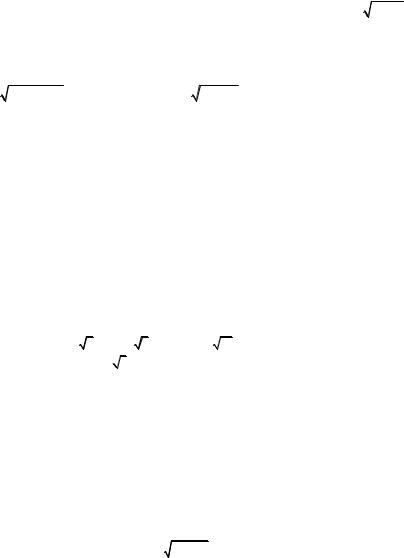
4. |
∫∫(2x + 3y + 5z)dσ, if σ is the part of the plane 2x + 3y + 5z = 30, placed |
||||||||||
|
σ |
|
|
|
|
|
|
|
|
|
|
in the first octant. |
|
|
|
|
|
|
|
|
|
|
|
Evaluate the surface integral of the second type over the given surface. |
|
||||||||||
5. |
∫∫ ( y2 + z2 )dxdy, if σ is the external side of the cylinder part z = |
9 − x2 , |
|||||||||
|
σ |
and y |
= 2. |
|
|
|
|
|
|
||
placed between planes y = 0 |
|
|
|
|
|
|
|||||
6. |
∫∫ (x2 + y2 + z2 )dxdy, |
if |
σ is the external side |
of a |
hemisphere |
part |
|||||
|
σ |
|
|
|
|
|
|
|
|
|
|
y = |
1− x2 − z2 , cut out by a cone |
y = |
x2 + z2 . |
|
|
|
|
|
|
||
7. |
∫∫ x2 dydz + y2dxdz + z2dxdy, |
if |
σ is the external |
side |
of a sphere |
part, |
|||||
|
σ |
|
|
|
|
|
|
|
|
|
|
placed in first octant. |
|
|
|
|
|
|
|
|
|
|
|
8. |
∫∫ zdxdy − ydydz, if σ is |
triangle formed by section of a plane |
6x − |
||||||||
|
σ |
|
|
|
|
|
|
|
|
|
|
− 3y + 2z = 6 with coordinate planes and a normal to the selected side creates an |
|||||||||||
acute angle with the axis Oz. |
|
|
|
|
|
|
|
|
|
|
|
9. |
∫∫ xdydz + ydxdz + zdxdy, |
if σ is the external side of a sphere x2 + y2 + |
|||||||||
|
σ |
|
|
|
|
|
|
|
|
|
|
+ z2 = R2 . |
|
|
|
|
|
|
|
|
|
|
|
10. Calculate coordinates |
of |
mass centre |
of a |
homogeneous |
surface |
||||||
2z = 4 − x2 − y2 (z ≥ 0) . |
|
|
|
|
|
|
|
|
|
|
|
|
|
|
Answers |
|
|
|
|
|
|
||
1. |
2πR4. 2. 52 2π. 3. 29 |
3π / 6. |
4. |
450 14. |
5. 88. |
6. |
π / 2. 7. 3πR4 /8. 8. 3. |
||||
9. 4πR3. 10. (0; 0; 307 − 15 5)/310. |
|
|
|
|
|
|
|
|
|||
Micromodule 8
SELF—TEST ASSINMENTS
8.1. Evaluate the surface integrals of the first type over the surface G (Table 8.1).
|
|
|
|
|
|
|
|
|
Table 8.1 |
|
|
|
|
|
|
|
|
|
|
№ |
|
|
Integral |
|
|
The equation |
Additional conditions |
||
|
|
|
|
of surface G |
|||||
|
|
|
|
|
|
|
|
|
|
8.1.1 |
∫∫(x |
2 |
+ y |
2 |
+ z |
2 |
)dσ |
z = x2 + y2 |
Surface G is bounded by |
|
|
|
planes z = 0 , z = 2 |
||||||
|
G |
|
|
|
|
|
|
|
|
|
|
|
|
|
|
|
|
|
199 |
http://vk.com/studentu_tk, http://studentu.tk/

|
|
|
|
|
|
|
|
|
|
|
|
|
|
|
|
|
|
|
|
|
|
|
|
|
Continuity of table 8.1 |
|
|
|
|
|
|
|
|
|
|
|
|
|
|
|
|
|
|
|
|
|
|
|
|
|
|
№ |
|
|
|
Integral |
|
|
|
|
|
|
|
The equation |
Additional conditions |
||||||||||||
|
|
|
|
|
|
|
|
|
|
of surface G |
|||||||||||||||
|
|
|
|
|
|
|
|
|
|
|
|
|
|
|
|
|
|||||||||
8.1.2 |
∫∫ ydq |
|
|
|
|
|
|
|
|
z = |
|
|
9 − x2 − y2 |
|
|||||||||||
|
G |
|
|
|
|
|
|
|
|
|
|
|
|
|
|
|
|
|
|
|
|
|
|
|
|
8.1.3 |
∫∫ xyzdq |
|
|
|
|
|
|
|
x + y + z = 1 |
Surface G is placed in the first |
|||||||||||||||
|
G |
|
|
|
|
|
|
|
|
|
|
|
|
|
|
|
|
|
|
|
|
|
|
|
octant |
8.1.4 |
∫∫(3z + 6x + 4y)dq |
|
x |
+ |
y |
+ |
|
z |
= 1 |
Surface G is placed in the first |
|||||||||||||||
2 |
|
|
|
|
octant |
||||||||||||||||||||
|
G |
|
|
|
|
|
|
|
|
|
|
|
|
3 |
|
4 |
|
|
|||||||
8.1.5 |
∫∫ |
16 − x2 − y2 dq |
|
z = − 16 − x2 − y2 |
|
||||||||||||||||||||
|
G |
|
|
|
|
|
|
|
|
|
|
|
|
|
|
|
|
|
|
|
|
|
|
|
|
|
|
|
|
|
|
|
|
|
|
|
|
|
|||||||||||||
8.1.6 |
∫∫(x2 + y2 )dq |
|
|
|
|
x2 + y2 + z2 = 4 |
z ≥ 0 |
||||||||||||||||||
|
G |
|
|
|
|
|
|
|
|
|
|
|
|
|
|
|
|
|
|
|
|
|
|
|
|
|
|
|
|
|
|
|
|
|
|
|
|
|
|
|
|
|
|||||||||
8.1.7 |
∫∫ x2 z2dq |
|
|
|
|
|
|
|
y = |
25 − x2 − z2 |
|
||||||||||||||
|
G |
|
|
|
|
|
|
|
|
|
|
|
|
|
|
|
|
|
|
|
|
|
|
|
|
8.1.8 |
∫∫ |
y |
2 |
+ z |
2 |
dq |
|
|
|
|
z |
2 |
|
+ |
y |
2 |
|
− x2 = 0 |
Surface G is bounded by planes |
||||||
|
|
|
|
|
|
|
|
|
|
x = 0 , x = 1 |
|||||||||||||||
|
|
|
|
|
16 |
|
|
|
|
||||||||||||||||
|
G |
|
|
|
|
|
|
|
|
|
|
|
|
|
|
9 |
|
|
|
|
|||||
8.1.9 |
∫∫ |
|
|
|
dq |
|
|
|
|
|
|
x2 + z2 = 16 |
Surface G is bounded by planes |
||||||||||||
x2 + y2 |
+ z2 |
|
|
|
y = 0, y = 2 |
||||||||||||||||||||
|
G |
|
|
|
|
|
|
|
|
|
|
|
|
|
|
|
|
|
|
|
|
|
|
|
|
8.1.10 |
∫∫(x2 + z2 )dq |
|
|
|
|
y = 1− x2 − z2 |
y ≥ 0 |
||||||||||||||||||
|
G |
|
|
|
|
|
|
|
|
|
|
|
|
|
|
|
|
|
|
|
|
|
|
|
|
8.1.11 |
∫∫ |
(x |
2 |
+ y |
2 |
+ z |
2 |
)dq |
|
y = |
x2 + z2 |
Surface G is bounded by planes |
|||||||||||||
|
|
|
|
|
y = 0, y = 4 |
||||||||||||||||||||
|
G |
|
|
|
|
|
|
|
|
|
|
|
|
|
|
|
|
|
|
|
|
|
|
|
|
|
|
|
|
|
|
|
|
|
|
|
|
|
|
|
|
||||||||||
8.1.12 |
∫∫ xdq |
|
|
|
|
|
|
|
|
z = |
|
|
16 − x2 − y2 |
|
|||||||||||
|
G |
|
|
|
|
|
|
|
|
|
|
|
|
|
|
|
|
|
|
|
|
|
|
|
|
8.1.13 |
∫∫ y2 zdq |
|
|
|
|
|
|
|
x + 2y + z = 1 |
Surface G is placed in the first |
|||||||||||||||
|
G |
|
|
|
|
|
|
|
|
|
|
|
|
|
|
|
|
|
|
|
|
|
|
|
octant |
8.1.14 |
∫∫(z + 2x + 3y)dq |
|
x |
+ |
y |
+ |
z |
= 1 |
Surface G is placed in the first |
||||||||||||||||
3 |
|
|
octant |
||||||||||||||||||||||
|
G |
|
|
|
|
|
|
|
|
|
|
|
|
2 |
|
6 |
|
|
|||||||
8.1.15 |
∫∫ |
25 − x2 − z2 dq |
|
y = − |
|
25 − x2 − z2 |
|
||||||||||||||||||
|
G |
|
|
|
|
|
|
|
|
|
|
|
|
|
|
|
|
|
|
|
|
|
|
|
|
8.1.16 |
∫∫( y2 + z2 )dq |
|
|
|
|
x2 + y2 + z2 = 36 |
x ≥ 0 |
||||||||||||||||||
|
G |
|
|
|
|
|
|
|
|
|
|
|
|
|
|
|
|
|
|
|
|
|
|
|
|
|
|
|
|
|
|
|
|
|
|
|
|
|
|
|
|
|
|
|
|
|
|
|
|
|
|
200
http://vk.com/studentu_tk, http://studentu.tk/
